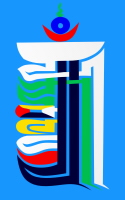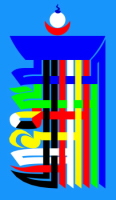 |
Kālacakra Monogram
|
 |
 |
Kālacakra Monogram
|
 |
This form of the monogram is usually shown with four upright bars (four "legs" rkang bzhi), and the image on the left is a computer enhanced version of a copy taken from a wood block carved by the great Jonang master Tāranātha. The block is preserved currently in Dzamthang, eastern Tibet. (A colour version is shown below.) An interestingly similar and rather beautiful design can be seen at this link depicting an 18th century enamel plate held in the National Palace Museum in Beijing. The most obvious difference between this version and the better known form shown on the previous page is that the first main syllable, which forms the "head" and right-hand "leg" of the monogram, is white instead of blue. This is the syllable "ha". In the generation process of Kālacakra, after the practitioner and the world have been imagined as having dissolved into emptiness, out of that emptiness a black (deep-blue) syllable "yaṃ" transforms into the disk of the element of wind. Above this, a red syllable "raṃ" transforms into the disk of the element of fire. Above this, a white syllable "vaṃ" transforms into the disk of the element of water, and then above this a yellow syllable "laṃ" transforms into the disk of the element of earth. A syllable "maṃ" then transforms into Mt. Meru, standing on the middle of the disk of earth. Mt. Meru has externally the four colours of black, red, white and yellow, and the syllable "maṃ" is generally considered also to consist of these colours. That is how it is depicted in the monogram. Then, on top of Meru, a green "kshaṃ" syllable transforms into a multi-coloured lotus. On the receptacle of this lotus a white syllable "haṃ" transforms into a moon disk. On top of this, a red shape of a crescent moon (a visarga) transforms into a sun disk, and finally on top of this a blue drop transforms into a disk of Rāhu. The drop, or bindu, is shown here like a ring (doughnut shape) rather than the usual circle. This is how the bindu should properly be drawn, as this is the normal form for the anusvāra, or bindu, in Indian writing. (Click here to see some images depicting this whole scene of the elements and Meru.) Continuing the meditation, these all then dissolve into a single Kālacakra monogram, "hkṣmlvryaṃ", which, given the colours just described, should be of the form shown on this page. (The final green wisp right on top of the monogram represents the purity of the element of space that permeates the whole scene.)
This form of the monogram, and particularly a coloured version of the design carved by Tāranātha, has been adapted into a logo for the Jonang tradition. See, for example, the use of it on this Jonang website: www.jonang.org/chinesebig5. Clicking on the image displays a larger version. The image below, linked in from another Jonang website, shows a metal version of Tāranātha's design, placed over a temple entrance in a monastery in eastern Tibet.
Last updated 4 February 2010. Return to Home Page. |